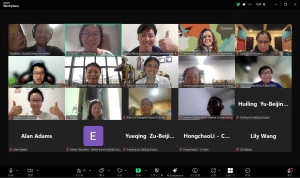This article is part of our special issue on New Trends in Philanthropy and Civil Society in China (Summer, 2011). It introduces arguably the most important development in the world of Chinese philanthropy in 2010: the establishment of a China Foundation Center (CFC) to strengthen information disclosure, transparency, and professionalism among China’s public and private foundations. The CFC is the result of 20 years of discussion, organizing, and lobbying by key individuals and organizations in the government, philanthropy and nonprofit sectors. Modeled on the U.S. Foundation Center, the CFC and its organizers clearly see the U.S. foundation world as a model to be emulated. They believe foundations need to be disciplined, transparent and professional if they are going to earn the support of a public that is largely skeptical about charity. At the same time, the CFC faces real challenges in terms of cost, technology and a lack of willingness (and ability) on the part of many foundations to disclose information. Support by more foundations for the CFC’s goals will be important if philanthropy in China is to move away from an environment in which the distribution of charitable donations is highly inequitable and skewed toward foundations with government ties.
On July 8, 2010, the China Foundation Center (基金会中心网, hereafter CFC) was established at a conference in Beijing. The CFC’s founders, drawn from 35 public and private foundations, urged that philanthropy must be transparent if it is to survive. A straw poll taken by conference participants revealed that many donors had limited knowledge about how their funds were used, the NGOs that received funding, or the tax incentives for donations. This was not surprising. China Youth Daily (中青报), a leading national publication, conducted an online poll with similar results.
In 2009, charitable donations in China totaled 50.9 billion RMB. In 2008, the year of the Sichuan earthquake, donations reached nearly 100 billion yuan, but if you take out 76 billion RMB in donations specifically for the earthquake relief effort, then 2009 did see a significant increase. China Youth Daily’s poll found that 94.8% of 15,796 individual respondents had given a donation. If these numbers reflect the wider population, then perhaps we can optimistically argue that China has entered an era of universal participation in public welfare charity**.
Moreover, 49.1 percent of poll respondents indicated that donors have the right and obligation to monitor their contributions; 48.2 percent expected grant recipients to be transparent; and 31.9 percent were unhappy or very dissatisfied with the state of public foundations and philanthropic organizations. These numbers show that the general public is increasingly more demanding about the use of donations.
Yet the poll also revealed that more than 50 percent of respondents did not understand how to take advantage of tax incentives related to charitable contributions and more than 70 percent were completely unaware of the tax incentives. The poll exposes major shortcomings for donors and NGOs with transparency and credibility playing the biggest role in restricting the development of charitable giving in China.
Ms. Zhuang Ailing, President of the China Foundation Center (CFC), hopes to change this situation. The CFC aims to encourage more donations by providing detailed information and analysis about more than 1,800 foundations across China.
In a study on philanthropic giving by the China Charity & Donation Information Center (中民慈善捐助信息中心), 90 percent of the public foundations disclose their bylaws, and 76.8 percent disclose the names of their board of directors. Only 30.4 percent publish an annual report and a mere 28 percent disclose financial statements. Most foundations are thus failing to meet the “Measures for Information Disclosure of Foundations” issued by the Ministry of Civil Affairs in 2006.
The overall lack of information, transparency, and mechanisms to track donations remains the biggest pitfall. While donor awareness has risen, this does not necessarily mean that donors are informed enough to select and supervise organizations who receive donations. According to the CFC, “most charity-related tax policies favor foundations, and the vast majority of donations are given to foundations, China Charity Federation (中华慈善总会), and the Chinese Red Cross (红十字会). Therefore, it is critical that foundations are transparent to ensure the development of the nonprofit and public welfare sector.”
Technology Triggers Change
When the CFC was developing a map to locate all the foundations across China, its vice president discovered that another foundation had its offices in the same building. Moreover, the Vantone Foundation (万通基金会), Narada Foundation (南都基金会) and Huaxia Foundation (华夏基金会) are all housed in the same office complex in Beijing. China’s leading search engine, Baidu, provides content and technical support for the CFC’s “charity map.” In addition, a geographic map of the foundations’ projects are available on the website.
Inspiration for the CFC came from the U.S. Foundation Center. With more than 98,000 foundations in its database, the U.S. Foundation Center has served as the information disclosure platform for American philanthropy for the last 50 years. From its headquarters in New York City and five regional offices across the U.S., the Foundation Center scours hundreds of sources to compile general information and financial data about each foundation. Additional details about specific programs are shared for more than 500 key foundations. The CFC is the U.S. Foundation Center’s first partner in China. The partnership covers information system support and capacity building, printing its exclusive publications, and opening its entire database to China
Twenty private foundations such as the Narada Foundation, Vantone Foundation, and YouChange Foundation(友成基金会), as well as 15 public fundraising foundations comprise the CFC’s network. Li Jin, Secretary-General of the Vantone Foundation revealed that he has already drafted information disclosure guidelines for private foundations to improve self-regulation. Results from the 2009 Private Foundation Development Forum reflect a growing consciousness within this group to actively self-regulate the industry.
Transparency Leads the Transformation of Public Philanthropy
“It was harder for Chinese foundations to self-regulate prior to (China) entering the WTO,” says Shang Yusheng, Founder and Chairman of the Beijing NGO Research and Development Center (北京恩玖非营利组织发展研究中心). Prior to 2000, foundations believed promoting people based on merit fulfilled the self-regulation requirement.
In fact, the CFC is the culmination of 20 years of relentless efforts by philanthropists, starting in 1990, when 14 Chinese foundations met at a conference in Chengde. Wang Zhenyao, Director of the One Foundation’s Philanthropy Research Center (壹基金公益研究院) at Beijing Normal University, adds that Mr. Shang and other key individuals aligned the China Charity Federation with 17 other foundations in 1998 to form the virtual China Foundation and NPO Information Network (中国基金会与NPO信息网) to encourage information sharing within the non-profit community. This event, the creation of the China Charity and Donation Information Center (中民慈善捐助信息中心) at the 2005 China Charity Conference, and the opening of the China Foundation Center represent three milestones of China’s move towards transparency in public philanthropy.
Shang Yusheng, Yan Mingfu (former president of the China Charity Federation), He Daofeng (executive vice president of the China Foundation for Poverty Alleviation,中国扶贫基金会), and Xu Yongguang (vice president and secretary general of the Narada Foundation) are pioneering individuals who led the development of self-regulation in Chinese foundations.
Yet, the individual who championed the government to broaden its thinking and established the Charity and Donation Information Center in 2005 was Wang Zhenyao, then Director of Disaster Relief at the Ministry of Civil Affairs.
NGO self-regulation in the last two decades has moved through several stages from proactive reporting to more government support, an influx of private capital, and increasing demands for transparency from media and academia, resulting in support from the government, business, and non-profit sectors. Foundations provide the impetus to enhance transparency and credibility of public charities and align aspirations, which ultimately forces structural changes for charitable organizations.
“The only way to get more support is by disclosing more,” says Xu Yongguang. The general public naturally gives money to organizations that openly share information. This in turn forces organizations to be accountable, thereby raising levels of efficiency and public awareness for charity and philanthropic NGOs. This also breaks from traditional views that all charities are government-run or have a government background, and it reduces the government’s need to intervene in philanthropy. Also, it would reduce the compulsory (被募捐) nature of some fundraising activities in which individuals are “encouraged” to donate by their work units.
Will Embracing Transparency Create an Elite Class?
The opening of the CFC demonstrates the willingness of Chinese foundations to develop, but it also adds new pressures and responsibilities.
Gu Xiaojin, Secretary-General of the China Youth Development Foundation (中国青少年发展基会), raises the question: “Donating to causes has become fashionable, but can foundations develop professionalism? Informing the public is not a simple matter. It requires technology, resources, and experienced talent in order to be effective.”
Xu Yongguang admits that collecting information is difficult for the CFC given technology and cost constraints. Even experienced foundations regarded as leaders in the field, such as the China Youth Development Foundation and China Foundation for Poverty Alleviation, feel disclosing information will not easy. Because of these challenges, many foundations are unable or even unwilling to disclose how their funds are being spent. The lack of information and insufficient transparency in the public welfare sector poses a serious challenge to the CFC.
The CFC is dedicated to upholding transparency and ensuring the fair distribution of funds, a major departure from the traditional way of charitable giving. Amity Foundation (爱德基金会)Secretary-General Qiu Zhonghui explains that, in the past, government departments often issued notices restricting organizations from receiving donations, with the exception of public foundations that were legally authorized to engage in fundraising. This planned economy management system should be removed so that NGOs can freely receive funds in the open market.
On July 7, 2010, China’s Ministry of Civil Affairs and five other ministries issued “Measures for Disaster Relief and Donations Management for the Yushu, Qinghai Earthquake.” This regulation required all charity organizations that raised funds for earthquake relief efforts to forward them to special accounts established by the Qinghai Provincial Government, Qinghai Red Cross and the Qinghai Charity Federation (青海省慈善总会). This measure affected 15 public foundations, and tens of billions in charitable donations, and prompted a public outcry about whether these donations might go into government coffers instead of being for their intended purposes. It was an abrupt about-face by the government. Not long before this, the Ministry of Civil Affairs had issued a notice allowing these same 15 social organizations and foundations, including the Red Cross and China Charity Federation, to accept donations for disaster relief. Government actions like this obstruct the role of NGOS and do more harm than good to the development of philanthropy.
Jia Xijin, deputy director of Tsinghua University’s NGO Research Institute, states that the reason for the government’s monopoly of charitable giving is a lack of trust among individuals. This distrust extends to donor organizations with a government background.
Thus, the CFC fills a desperately needed venue for citizens and businesses to provide funds directly to those who need it the most. Zhuang Ailing acknowledges that the large number of private foundations is having an impact on public foundations. Previously, many companies that gave to public foundations and were dissatisfied with the results went ahead and conducted charitable programs on their own, which they ultimately found more challenging than rewarding. The 2004 Regulations for the Management of Foundations filled a gap by allowing companies to create their own foundations. It is also the CFC’s mission to promote transparency among these foundations and encourage their healthy development ((Editor’s Note: The 2004 Regulations essentially created a new category of private (literally: nonpublic fundraising) foundations that could be established with privately-endowed donations from a family or company. These private foundations would complement the older generation of government-supported public foundations that emerged in the 1980s and 1990s.)).
However, the most optimistic assessments of the industry are not shared within the CFC. An important reason, says Zhuang Ailing, is that donors increasingly expect recipient organizations to have no conflicts of interest. Moreover, assessment and evaluation will be a future problem.
The China Foundation Center is not a fee-based membership network where foundations subscribe to different services. It remains a neutral and open platform for information and support, enabling socially-minded citizens to track their donations and determine if they are being used effectively. Advanced technology allows detailed information to be delivered in an efficient and cost-effective manner. The only way for foundations to survive is to be transparent. In this way, donors can help civil society develop without pressure or fear of resource misallocation.
Chen Yimei, China director of Mercy Corps International, asserts that Chinese philanthropic organizations are moving along a path from transparency to effectiveness and to strategic philanthropy. Social progress is a long process, but it’s important that this process is open.
Transparency not only protects wealth, but also ensures its proper use.
** Editor’s Note: As the survey was conducted through the China Youth Daily website, a higher proportion of respondents are from urban areas where occupation, age, educational background, and donation experience are higher than in rural areas.



